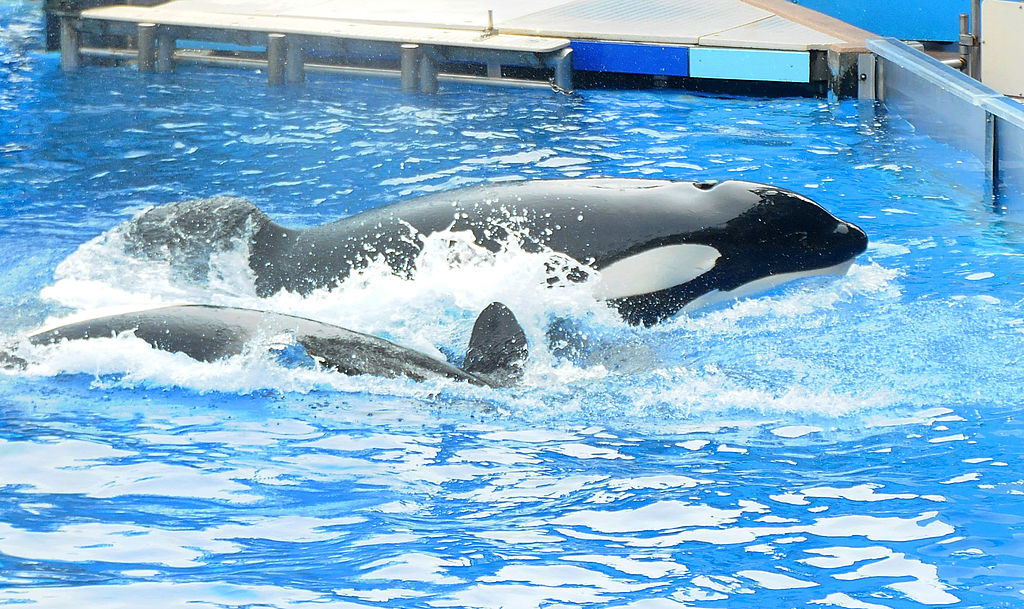How Tilikum the Orca Changed the Conversation About Animals in Captivity

Tilikum, the orca at the center of the 2013 documentary "Blackfish," has died at SeaWorld Orlando, the marine park announced Friday (Jan. 6).
According to SeaWorld, Tilikum died early in the morning. The cause of death is officially unknown, but the killer whale had been under long-term treatment for a persistent bacterial lung infection. In March 2016, SeaWorld announced that Tilikum was lethargic and seemed to be deteriorating, but his condition improved.
Tilikum was the focus of a controversy over the ethics of keeping orcas in captivity. Over his approximately 33 years in captivity, he was involved in three human deaths, including the death of a trainer at SeaWorld in front of a horrified audience of onlookers after a show in 2010. Those interviewed in "Blackfish" argued that the whale had essentially become psychotic after being torn from his close-knit wild pod at a young age and kept in barren, isolated tanks.
"You really felt personally connected to him as an individual animal [in the documentary]," said Brian Ogle, an anthrozoologist at Beacon College in Florida who studies interactions between humans and captive animals. "I think that's why that movie was so successful." [Image Gallery: Russia's Beautiful Killer Whales]
Tilikum's story launched a public conversation about large marine mammals in captivity, including how to make life in a pool better for these animals. But it also opened up a broader debate about whether to keep large mammals in captivity at all, Ogle said.
"It's a double-edged sword," he said. "You have to look at it from the perspective that if these animals weren't in captivity to begin with, would we have cared so much about them as we do now?"
Tilikum's influence
In March 2016, due to declining SeaWorld ticket sales, political pressure from California lawmakers and public backlash because of "Blackfish," SeaWorld announced that it would end its captive breeding program. The California Coastal Commission had made permits for SeaWorld's expansion in San Diego contingent on the park ending killer-whale breeding in the state.
Get the world’s most fascinating discoveries delivered straight to your inbox.
The park also ended its circus-style, trick-filled orca shows. The orca shows at the parks have been altered to show off more naturalistic behaviors in the whales.
As has been documented by "Blackfish" and Outside magazine, Tilikum was captured from the wild off the coast of Iceland in 1983, when he was approximately 2 years old. Killer whales are intensely social, and males typically stay with their mothers for decades, if not for life. Males don't reach full sexual maturity until age 25, according to the Center for Whale Research. [Whale Gallery: Giants of the Deep]
Tilikum was kept in a tank at a marine zoo in Reykjavík, Iceland, for a year before being purchased by Sealand of the Pacific, a marine park in British Columbia. There, he was kept in a pen open to a marina along with two females that bullied him to establish dominance. In 1991, the three whales killed a 20-year-old part-time trainer who slipped into their pool. It was the first killing by an orca at a marine park — in fact, it was the first killing of a human by orcas ever reported, as killer whales have never killed a person in the wild.
A public conversation
Tilikum was shipped to SeaWorld shortly after the incident. In 1999, he was involved in the death of another human, a man who snuck into his tank after hours. Whether Tilikum actually killed the man is a mystery, but the man's body was found drowned, mutilated and draped over the whale the next morning.
It was the death of SeaWorld's Dawn Brancheau in 2010, however, that catapulted Tilikum to notoriety. The whale dragged her into the water after a show, drowning her as park employees tried to usher away park guests.
The Occupational Safety and Health Administration (OSHA) opened an investigation into SeaWorld after Brancheau's death, but it was "Blackfish," which outlined Tilikum's tragic beginnings, that kicked off public outrage about orcas in captivity. People in the animal care world call it the "Blackfish effect," Ogle told Live Science, and the resulting sentiment has transferred beyond orcas to other large captive mammals.
"I really believe if the whole issue with 'Blackfish' would not have happened, we would have been having a same or similar conversation, but it would have been around elephants," Ogle said. "I really think zoos kind of dodged a bullet."
Zoos have been updating elephant habitat in recent years and resigning themselves to transferring elephants they can't care for, Ogle said. The focus on orcas after "Blackfish" allowed them to make a lot of that progress quietly, without much public attention.
"I think the zoo industry as a whole has learned from SeaWorld," Ogle said. The marine park didn't prepare a rapid public-relations response to Blackfish, he said, and when they did respond, it came across as evasive and defensive, he said.
"They didn't respond in a manner that made it look like they weren't doing anything wrong," Ogle said.
Some animal activists advocate releasing today's captive killer whales, but many zoo professionals say releasing the orcas would be akin to a death sentence. Both sides genuinely want to do the right thing for the whales, Ogle said.
"They're having a hard time finding a middle ground in what's actually best for those animals," Ogle said.
Original article on Live Science.

Stephanie Pappas is a contributing writer for Live Science, covering topics ranging from geoscience to archaeology to the human brain and behavior. She was previously a senior writer for Live Science but is now a freelancer based in Denver, Colorado, and regularly contributes to Scientific American and The Monitor, the monthly magazine of the American Psychological Association. Stephanie received a bachelor's degree in psychology from the University of South Carolina and a graduate certificate in science communication from the University of California, Santa Cruz.


